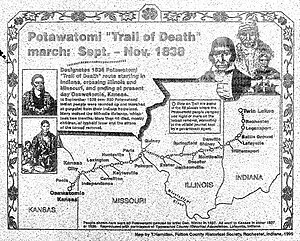| Potawatomi Trail of Death | |
|---|---|
| Part of Indian removal | |
 Map of the trail route: The tribe traveled from Twin Lakes, Indiana, arriving in Osawatomie, Kansas two months later. | |
| Location | United States |
| Date | November 4, 1838 |
| Target | Potawatomi |
Attack type | Population transfer, ethnic cleansing |
| Deaths | 40+ |
| Perpetrators | United States |
| Motive | Expansionism |
The Potawatomi Trail of Death was the forced removal by militia in 1838 of about 859 members of the Potawatomi nation from Indiana to reservation lands in what is now eastern Kansas.
The march began at Twin Lakes, Indiana (Myers Lake and Cook Lake, near Plymouth, Indiana) on November 4, 1838, along the western bank of the Osage River, ending near present-day Osawatomie, Kansas. During the journey of approximately 660 miles (1,060 km) over 61 days, more than 40 people died, most of them children. It was the single largest Indian removal in Indiana history.
Although the Potawatomi had ceded their lands in Indiana to the federal government under a series of treaties made between 1818 and 1837, Chief Menominee and his Yellow River band at Twin Lakes refused to leave, even after the August 5, 1838, treaty deadline for departure. Indiana governor David Wallace authorized General John Tipton to mobilize a local militia of one hundred volunteers to forcibly remove the Potawatomi from the state. On August 30, 1838, Tipton's militia surprised the Potawatomi at Twin Lakes, where they surrounded the village and gathered the remaining Potawatomi together for their removal to Kansas. Father Benjamin Marie Petit, a Catholic missionary at Twin Lakes, joined his parishioners on their difficult journey from Indiana, across Illinois and Missouri, into Kansas. There the Potawatomi were placed under the supervision of the local Indian agent (Jesuit) father Christian Hoecken at Saint Mary's Sugar Creek Mission, the true endpoint of the march.
Historian Jacob Piatt Dunn is credited for naming "The Trail of Death" in his book, True Indian Stories (1909). The Trail of Death was declared a Regional Historic Trail in 1994 by the state legislatures of Indiana, Illinois, and Kansas; Missouri passed similar legislation in 1996. As of 2013[update], 80 Trail of Death markers were located along the route in all four states, at every 15 to 20 miles where the group had camped between each day's walk. Historic highway signs signal each turn along the way in Indiana in Marshall, Fulton, Cass, Carroll, Tippecanoe, and Warren counties. Many signs are in Illinois, Missouri, and the three Kansas counties.